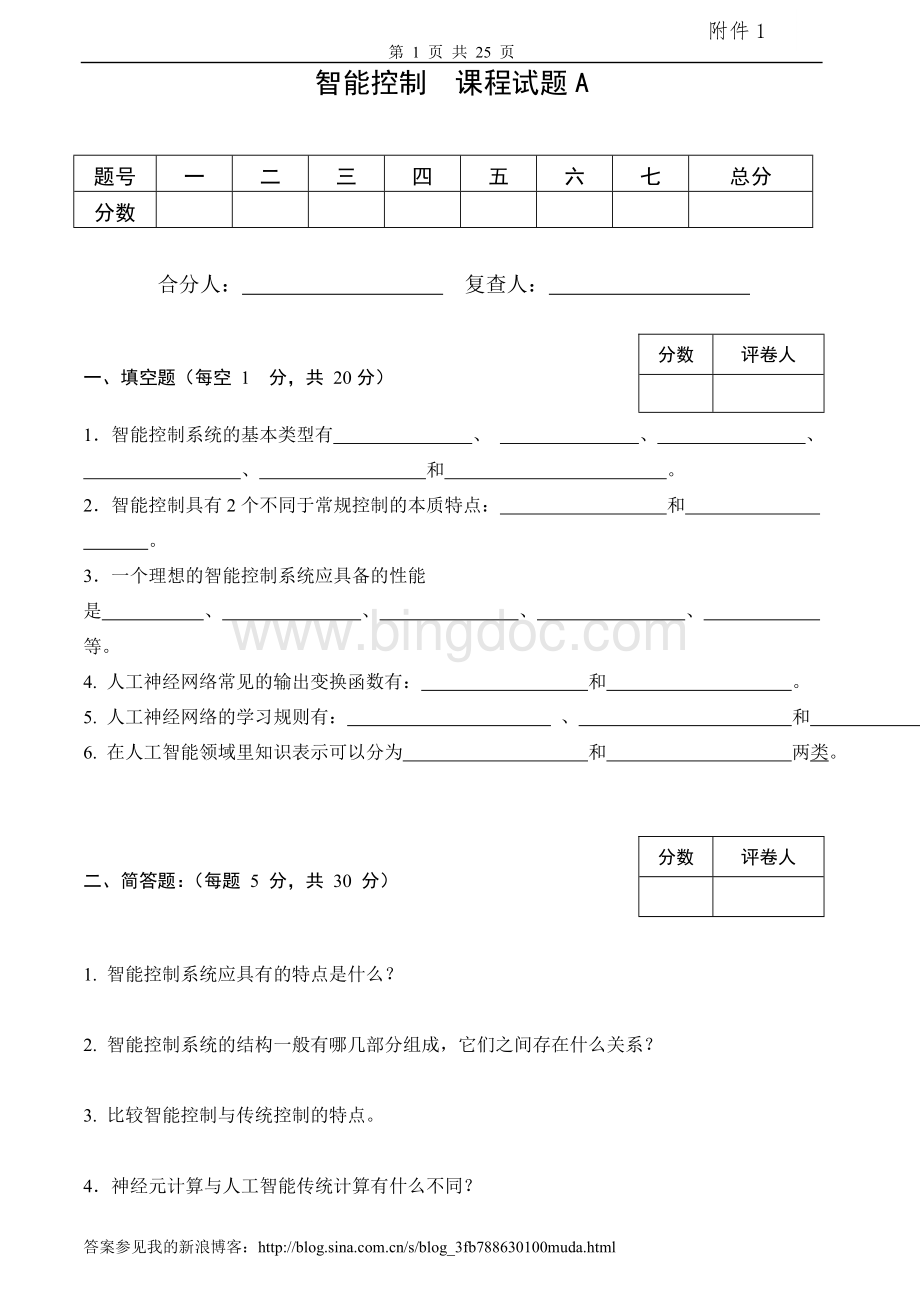智能控制试卷及答案4套文档格式.doc
《智能控制试卷及答案4套文档格式.doc》由会员分享,可在线阅读,更多相关《智能控制试卷及答案4套文档格式.doc(25页珍藏版)》请在冰点文库上搜索。

复查人:
一、填空题(每空1分,共20分)
评卷人
1.智能控制系统的基本类型有、、、
、和。
2.智能控制具有2个不同于常规控制的本质特点:
和
。
3.一个理想的智能控制系统应具备的性能是、、、、等。
4.人工神经网络常见的输出变换函数有:
和。
5.人工神经网络的学习规则有:
、和。
6.在人工智能领域里知识表示可以分为和两类。
二、简答题:
(每题5分,共30分)
1.智能控制系统应具有的特点是什么?
2.智能控制系统的结构一般有哪几部分组成,它们之间存在什么关系?
3.比较智能控制与传统控制的特点。
4.神经元计算与人工智能传统计算有什么不同?
5.人工神经元网络的拓扑结构主要有哪几种?
6.简述专家系统与传统程序的区别。
三、作图题:
(每图4分,共20分)
1.画出以下应用场合下适当的隶属函数:
(a)我们绝对相信附近的e(t)是“正小”,只有当e(t)足够远离时,我们才失去e(t)是“正小”的信心;
(b)我们相信附近的e(t)是“正大”,而对于远离的e(t)我们很快失去信心;
(c)随着e(t)从向左移动,我们很快失去信心,而随着e(t)从向右移动,我们较慢失去信心。
2.画出以下两种情况的隶属函数:
(a)精确集合的隶属函数;
(b)写出单一模糊(singletonfuzzification)隶属函数的数学表达形式,并画出隶属函数图。
四、计算题:
(每题10分,共20分)
1.一个模糊系统的输入和输出的隶属函数如图1所示。
试计算以下条件和规则的隶属函数:
(a)规则1:
Iferroriszeroandchang-in-erroriszeroThenforceiszero。
均使用最小化操作表示蕴含(usingminimumopertor);
(b)规则2:
Iferroriszeroandchang-in-errorispossmallThenforceisnegsmall。
均使用乘积操作表示蕴含(usingproductopertor);
2.设论域,且
试求(补集),(补集)
五、试论述对BP网络算法的改进。
(共10分)
智能控制课程试题B
1.智能控制的研究对象具备的特点有:
、和
。
2.智能控制系统的主要类型有:
、、
、、和。
3.确定隶属函数的方法大致有、和
4.国内外学者提出了许多面向对象的神经网络控制结构和方法,从大类上看,较具代表性的有以下几种:
、和。
5.在一个神经网络中,常常根据处理单元的不同处理功能,将处理单元分成有以下三种:
6.专家系统具有三个重要的特征是:
1.智能控制有哪些应用领域?
试举例说明其工作原理。
2.试说明智能控制的三元结构,并画出展示它们之间关系的示意图。
3.模糊逻辑与随机事件的联系与区别。
4.给出典型的神经元模型。
5.BP基本算法的优缺点。
6.专家系统的基本组成。
(a)随着e(t)从向左移动,我们很快失去信心,而随着e(t)从向右移动,我们较慢失去信心。
(c)我们绝对相信附近的e(t)是“正小”,只有当e(t)足够远离时,我们才失去e(t)是“正小”的信心;
Iferroriszeroandchang-in-errorisnegsmallThenforceispossmall。
五、试论述建立专家系统的步骤。
智能控制课程试题C
1.智能控制是一门新兴的学科,它具有非常广泛的应用领域,例如
、、、和
。
2.传统控制包括和。
4.学习系统的四个基本组成部分是、、、
。
5.专家系统的基本组成部分是、、。
7.智能控制系统的结构一般有哪几部分组成,它们之间存在什么关系?
8.智能控制系统有哪些类型,各自的特点是什么?
9.比较智能控制与传统控制的特点。
4.根据外部环境所提供的知识信息与学习模块之间的相互作用方式,机器学习可以划分为哪几种方式?
5.建造专家控制系统大体需要哪五个步骤?
6.为了把专家系统技术应用于直接专家控制系统,在专家系统设计上必须遵循的原则是什么?
五、画出静态多层前向人工神经网络(BP网络)的结构图,并简述BP神经网络的工作过程(10分)
。
智能控制课程试题D
、、、、和。
3.一个理想的智能控制系统应具备的性智能能是、
、等。
4.在设计知识表达方法时,必须从表达方法的、
、这四个方面全面加以均衡考虑。
5.在一个神经网络中,常常根据处理单元的不同处理功能,将处理单元分成输入单元、输出单元和三类。
10.智能控制系统的结构一般有哪几部分组成,它们之间存在什么关系?
11.试说明智能控制的三元结构,并画出展示它们之间关系的示意图。
12.比较智能控制与传统控制的特点。
4.神经网络应具的四个基本属性是什么?
5.神经网络的学习方法有哪些?
6.按照专家系统所求解问题的性质,可分为哪几种类型?
五、试述专家控制系统的工作原理(共10分)
Fuzzycontrolofaball-balancingsystem
Ⅰ.Introduction
Theball-balancingsystemconsistsofacartwithanarcmadeoftwoparallelpipesonwhichasteelballrolls.Thecartmovesonapairoftrackshorizontallymountedonaheavysupport(Fig.1).Thecontrolobjectiveistobalancetheballonthetopofthearcandatthesametimeplacethecartinadesiredposition.Itiseducational,becausethelaboratoryrigissufficientlyslowforvisualinspectionofdifferentcontrolstrategiesandthemathematicalmodelissufficientlycomplextobechallenging.Itisaclassicalpendulumproblem,liketheonesusedasabenchmarkproblemforfuzzyandneuralnetcontrollers,assalesmaterialforfuzzydesigntools.
Initially,thecartisinthemiddleofthetrackandtheballisontheleftsideofthecurvedarc.Acontrollerpullsthecartlefttogettheballupnearthemiddle,thenthecontrolleradjuststhecartpositionverycarefully,withoutloosingtheball.
Fuzzycontrolprovidesaformatmethodologyforrepresenting,manipulatingandimplementingahuman’sheuristicknowledgeabouthowtocontrolasystem[1-3].Here,thefuzzycontroldesignmethodwillbeusedtocontroltheball-balancingsystem.
Fig.1Ball-balancinglaboratoryrig
Ⅱ.Designobjective
a).Learningtheoperatingprincipleoftheball-balancingsystem;
b).Masteringthefuzzycontrolprincipleanddesignprocedure;
c).Enhancingtheprogrammingpowerusingmatlab.
Ⅲ.Designrequirements
a).Balancingtheballonthetopofthearcandatthesametimeplacethecartinadesiredposition.
b).Comparingthecontrolresultofthelinearcontrollerwiththatofthefuzzycontrollerandthinkingabouttheadvantageoffuzzycontroltoconventionalcontrol.
Ⅳ.Designprinciple
①Modeldescriptionoftheball-balancingsystem
Introducethestatevectorofstatevariables(representscartpositionand
representsballangulardeviation)
Thenonlinearstate-spaceequations[5]aregivenasfollows:
Whererepresentscartradiusofthearc,isthecartweight,representscartdrivingforce,istheballradius,istheballrollingradius,istheballweight,istheballmomentofinertiaandrepresentsgravity.
Themodelcanbelinearisedaroundtheorigin.Theapproximationstothetrigonometricfunctionsareintroducedasfollows
andthelinearstate-spacemodelcanbeobtainedasfollows
Matricesaresimplyandgivenasfollows
with,
Theactualvaluesoftheconstantsare.
②Fuzzycontrollerdesign
Therearespecificcomponentscharactersticofafuzzycontrollertosupportadesignprocedure.IntheblockdiagraminFig.2,thefuzzycontrollerhasfourmaincomponents.Thefollowingexplainstheblockdiagram.
Fig.2Fuzzycontrollerarchitecture
a.Fuzzification
Thefirstcomponentisfuzzification,whichconvertseachpieceofinputdatatodegreesofmembershipbyalookupinoneofseveralmembershipfunctions.Thefuzzificationblockthusmatchestheinputdatawiththeconditionsoftherulestodeterminehowwelltheconditionofeachrulematchesthatparticularinputinstance.
b.Rulebase
Therulebasecontainsafuzzylogicquantificationoftheexpert’slinguisticdescriptionofhowtoachievegoodcontrol.
c.Inferenceengine
Fore